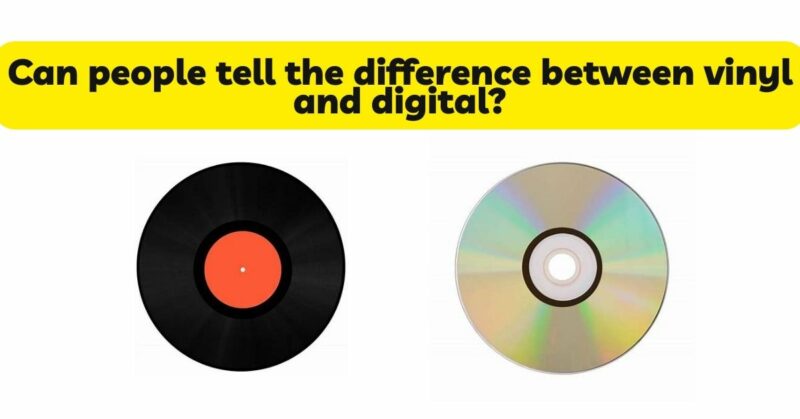In the realm of audio playback, the debate between vinyl and digital formats has raged on for decades. Audiophiles and music enthusiasts passionately discuss the differences in sound quality and argue whether vinyl records offer a distinct advantage over digital formats. In this article, we will delve into the question of whether people can truly tell the difference between vinyl and digital audio, exploring the technical aspects, subjective perception, and scientific studies that shed light on this intriguing conundrum.
- Understanding the Technical Differences: To examine the ability to discern between vinyl and digital audio, it is important to understand the technical disparities between the two formats. Vinyl records rely on analog playback, where grooves on the record are physically traced by a stylus, generating electrical signals that are amplified and reproduced as sound. Digital formats, on the other hand, convert audio into a series of binary digits (0s and 1s), which are then processed and reconstructed into an analog signal for playback.
- Perception and Subjectivity: The perception of sound quality is subjective and can vary greatly among individuals. Factors such as personal preferences, listening experience, equipment quality, and environmental conditions all play a role in shaping one’s perception of audio quality. These subjective factors can significantly influence whether individuals can discern differences between vinyl and digital audio.
- Technical Advancements in Digital Audio: Digital audio formats, such as CDs and high-resolution files, have made significant advancements in recent years. With higher bit depths and sampling rates, as well as improvements in digital-to-analog conversion technology, digital audio can achieve high levels of accuracy and fidelity. These advancements have narrowed the gap between vinyl and digital formats, challenging the notion that vinyl always outperforms digital in terms of sound quality.
- Analog Warmth and Characteristics: Vinyl enthusiasts often argue that the analog nature of vinyl playback imparts a certain warmth and unique sonic character that digital formats cannot replicate. The inherent imperfections of vinyl, such as surface noise, pops, and crackles, contribute to the nostalgic and authentic appeal of the medium. Some listeners believe that these analog characteristics create a more engaging and immersive listening experience.
- Listener Experience and Training: Listeners with extensive experience and training in audio production, engineering, or music performance may have a heightened ability to discern subtle differences in sound quality. Training and exposure to different audio systems, combined with a familiarity with specific recordings and genres, can enhance the listener’s ability to detect nuances and artifacts that distinguish vinyl from digital audio.
- Scientific Studies and Blind Listening Tests: Scientific studies and blind listening tests have been conducted to investigate the ability to discern between vinyl and digital audio. Results from these studies have been mixed, with some participants demonstrating the ability to detect differences, while others could not consistently identify the format. These studies highlight the variability and subjectivity of audio perception, indicating that not everyone can reliably tell the difference between vinyl and digital audio.
- Equipment Quality and Setup: The quality of audio equipment and the setup of the playback system play a significant role in the ability to discern differences between vinyl and digital audio. High-quality turntables, cartridges, amplifiers, and speakers, along with proper setup and calibration, can enhance the nuances and subtleties of vinyl playback. Similarly, a well-designed digital audio setup, including high-resolution digital-to-analog converters (DACs) and quality speakers or headphones, can provide accurate and transparent digital audio reproduction.
- Listening Conditions and Context: Listening conditions and context can greatly influence the perception of audio quality. Factors such as ambient noise, room acoustics, listening volume, and the listener’s mental state can impact the ability to discern differences between vinyl and digital audio. Controlled listening environments, where these factors areminimized, can provide a more accurate representation of the differences between vinyl and digital.
- Subjective Preferences and Emotional Connection: It is important to acknowledge that subjective preferences and emotional connections to the medium can heavily influence one’s perception of sound quality. Some listeners may have a strong affinity for vinyl records due to nostalgic associations, the tactile experience of handling records, or a preference for the analog warmth and character. These subjective factors can contribute to the belief that vinyl sounds superior to digital.
- Personal Enjoyment and Engagement: Ultimately, the enjoyment and engagement derived from the listening experience should be a significant factor in assessing the differences between vinyl and digital audio. For many, the act of carefully handling a vinyl record, examining the artwork, and engaging in the ritualistic aspects of vinyl playback can create a more immersive and satisfying listening experience. This personal engagement can enhance the perception that vinyl sounds better than digital.
Conclusion: The ability to discern the difference between vinyl and digital audio is a complex and multifaceted question. While some listeners claim to perceive distinct characteristics and sonic differences, scientific studies and blind tests demonstrate the variability and subjectivity of audio perception. Factors such as personal preferences, listening experience, equipment quality, and the listening environment all contribute to the ability to detect nuances between vinyl and digital audio.Advancements in digital audio technology have significantly narrowed the gap in sound quality between vinyl and digital formats. Digital audio can achieve high levels of accuracy and fidelity, challenging the notion that vinyl always surpasses digital in terms of sound quality.Ultimately, the ability to tell the difference between vinyl and digital audio depends on individual listeners and their unique experiences. Personal enjoyment, engagement, and subjective preferences play a significant role in shaping one’s perception of sound quality. Whether vinyl or digital audio is preferred should be based on personal enjoyment, emotional connection, and the specific qualities that resonate with each listener.


